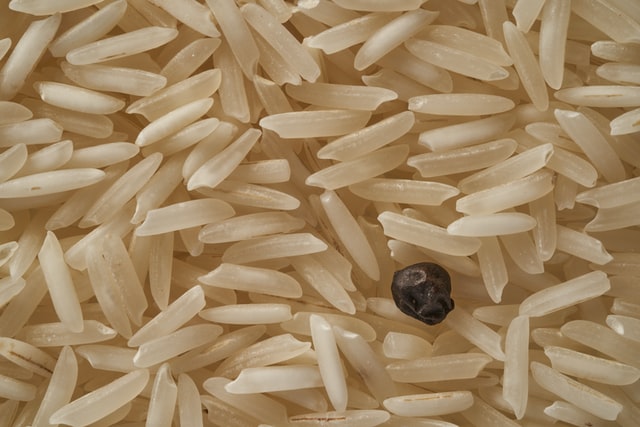Basmati rice; what is the benefit? Calorie content and composition of the product, benefits, and harm to the body. Cooking and cuisine, the history of diversity.
Basmati rice is one of the varieties of a cultivated plant from the cereal family. It differs from other varieties in the shape and size of edible seeds. The grains are long and thin, up to 7 mm long and up to 2 mm thick; romantics compare them to the shape of a Turkish dagger. The color is translucent, white, creamy, or creamy; the smell is floury, slightly sweet, with a touch of fried popcorn. The texture is smooth; the structure is crumbly.
Table of Contents
Basmati rice processing
This variety is rarely sold raw, like brown. The type is valued for its ability to grow 2 times after heat treatment while maintaining a crack. He gets priority when cooking pilaf, so the grains are carefully cleaned.
How basmati rice is prepared for sale
- Raw material (grain) is weighed, and randomly selected samples are evaluated in the laboratory for vitamin and mineral content.
- Drying occurs in a particular installation and removal of contaminants in a grain cleaning machine equipped with a centrifuge and a metal trap.
- The intermediate product is fed into a processing line with an integrated exfoliator, gravity separator, ricer and polisher, and suction system. Despite the increase in the cost of cleaning, a color separator is installed in the installation, which removes grains of other varieties.
- The purified basmati is sieved through a sieve. During the process, grains, crushed pieces, and flour are separated.
- The quality of the final product is checked in the laboratory. Then it is poured into polypropylene bags and sent to the warehouse. Preparation for sale consists of packaging in small quantities-0.5-1 kg.
You can buy basmati rice in any large store in India and Pakistan. The price for 1 kg is 5$-7$ respectively. The cost depends on the cleaning level and the company’s supplier.
Composition and calorie content of basmati rice
During heat treatment, the product’s nutritional value decreases, and the vitamin and mineral balance is destroyed. Therefore, cooking in an “al dente” state is recommended to preserve the beneficial properties as much as possible.
The calorie content of dry basmati rice is 340 kcal per 100 g, of which
- Protein – 7.6 g;
- Fat – 0.6 g;
- Carbohydrates – 79.7 g;
- Dietary fiber – 3.3 g.
Vitamins per 100 g
- Vitamin B1, thiamine – 0.1 mg;
- Vitamin B6, pyridoxine – 0.2 mg;
- Vitamin B9, folate – 8 micrograms;
- Vitamin K, phylloquinone – 0.1 mcg;
- Vitamin PP – 1.6 mg.
Macronutrients per 100 g
- Potassium, K – 115 mg;
- Calcium, Ca – 28 mg;
- Magnesium, Mg – 25 mg;
- Phosphorus, P – 115 mg.
Micronutrients per 100 g
- Iron, Fe – 0.8 mg;
- Selenium, Se – 0.015 μg;
- Zinc, Zn – 1.1 mg.
Cooking changes the energy value and vitamin-mineral composition of basmati rice.
The calorie content of basmati rice after boiling is 120 kcal per 100 g, of which
- Protein – 3.5 g;
- Fat – 0.4 g;
- Carbohydrates – 25.1 g;
- Dietary fiber – 0.4 g.
The vitamin complex is almost destroyed. A small amount of nicotinic acid remains – a substance necessary for the normal nervous system functioning, lowers cholesterol levels and increases hemoglobin. It is possible to notice the residual content of iron and multi nutrients, including potassium (32 mg) and calcium (1 mg), which are necessary for the functioning of the cardiovascular system and the regeneration of bone tissue.
The finished product contains another chemical compound that positively affects the human body. It gives the raw product a characteristic aroma and the cooked product a nutty taste.
Heat treatment changes not only the dish’s nutritional value but also the taste of the basmati rice. An adequately prepared product, where the maximum amount of nutrients has been preserved, is sweet, with a nutty flavor, dense in structure, slightly dried, and crumbly. If the cooking recommendations are violated, the grains are hard or, on the contrary, slimy. Such rice is used in medical diets, but it tastes unpleasant.

Is basmati a healthy rice?
Ayurvedic healers noticed the health effects of this variety on the body. They believe the product simultaneously saturates the human body with the energy of air, light, and water.
The health benefits of basmati rice are also not denied by official medicines. The soluble fiber in grains, entering the digestive tract, is transformed into a liquid gel, which forms a film on the surface of the mucous membrane of the stomach and duodenum, which protects against the aggressive effects of digestive juices.
The glycemic index of basmati rice after boiling is low – 56-58 units, so the product can be added to the diabetic diet. Normalizes blood sugar levels.
Benefits of basmati rice:
- Reduces the content of “bad” cholesterol, reducing atherosclerosis incidence.
- It takes a long time to digest, prevents hunger for a long time, and helps to get rid of extra pounds.
- It improves the condition of the skin and strengthens bones and cartilage tissue.
- It has an antioxidant effect and reduces malignant diseases, forming tumors in the digestive tract and mammary glands.
- Normalizes water and electrolyte balance. Relieves inflammation when used during a salt-free diet.
- It has a general tonic effect and helps to recover faster after physical or mental stress.
- Stabilizes the thyroid gland.
Basmati rice accelerates recovery from hepatitis A and rehabilitation from exacerbations of chronic pancreatitis. Only in this case should rotten grains be consumed.
